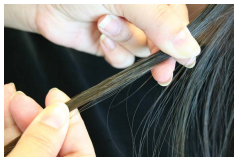Based on the patient's history, start by examining the hair to determine the overall pattern of hair loss or hair thinning. Inspect the scalp for erythema, scaling, pustules, tenderness, bogginess, and scarring. Look at the width of the hair part in various sections of the scalp. To examine the hair for shedding from the roots, perform a hair pull test by gently grasping 50 to 60 hairs with your thumb and index and middle fingers, pulling firmly away from the scalp (Fig. 1). If all the hairs have telogen bulbs, the most likely diagnosis is telogen effluvium. To examine the hair for fragility, perform the tug test by holding a group of hairs in one hand, pulling along the hair shafts with the other (Fig. 2); if any hairs break, it is abnormal. Most (97%) hair loss is nonscarring, but any scarring, namely shiny spots without any hair follicles on close examination with a magnifying glass, should prompt referral to dermatology for scalp biopsy.

FIGURE 1. Hair pull test.

FIGURE 2. Tug test.
责任编辑:admin
上一篇:没有了
下一篇:医学文章阅读——Skin Cancer Prevention

微信公众号搜索“译员”关注我们,每天为您推送翻译理论和技巧,外语学习及翻译招聘信息。